Tofino '06
This is the third summer in a row I’ve packed up my bathing suit, warm clothes, and penchant for moss and bull kelp, and headed over to Tofino. Version 3.0 included Kat and Gord, a rainy Thursday to Saturday, and a sunny Sunday and Monday. We pulled into Bella Pacifica Campground around 10 pm, a stone’s throw from a beautiful dark beach complete with full moon and pounding waves. We grabbed some drinks and explored, marveling at the powder-soft sand and the way the tide seeped toward the shore in little meandering rivers, trapping one lawnchair-reclined couple on a small sandy island. The fog created little ghostly orbs of light in our photos, and we fell asleep listening to the waves crash like an intermittent roaring river.

The next day was spent gathering info and deciding what to do. We ate fish and chips again at the Sea Shanty – permanently etched in my mind last year not only for the food, but also for its beautiful view of Tofino Air floatplanes taking off in the harbor. We then signed up for a four-hour kayaking tour, and then headed over to Schooner trail, a short boardwalk that leads down to the northern edge of Long Beach.
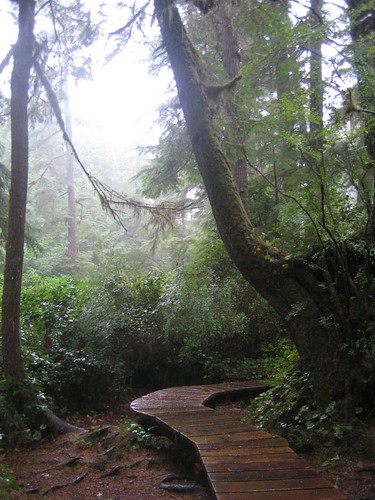
The rain was refreshing and we spotted a bear near our hiking trail. The weather ensured no other hikers on our trail. Bursting out of the forest in our tacky yellow ponchos, we came upon the most spectacular rainy beach – first nations reservation in the forest to our left, and rocky islands and a low tide in front of us.
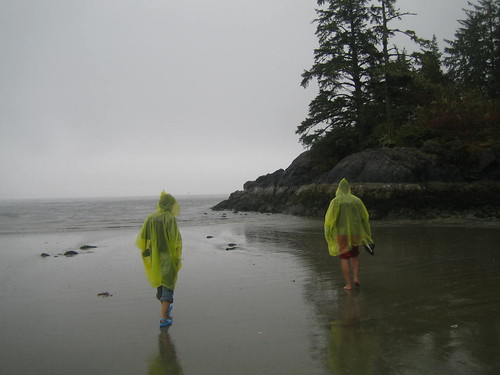
Hours drifted and blended as we poked and prodded at sea anemones, starfish, clams, and barnacles. Kat was particularly intrigued with these clams buried under the sand that shot water in our faces. After observing them for a while, she determined that they have an in-valve and an out-valve. I thought that they were perhaps geoducks, a kind of clam that burrows under the sand (to avoid the hungry Chinese). We tried to grab the clams but they burrowed too fast and we couldn’t even find them when we dug at the spot.
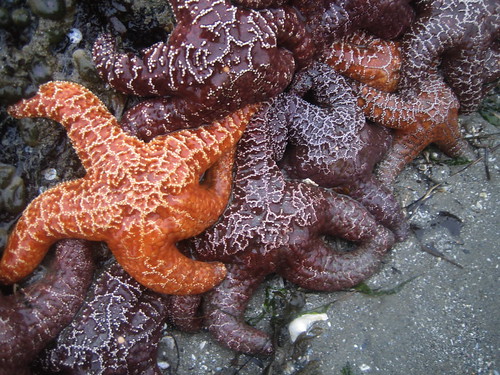
Other tidal pools had little fast brown spotted fish, and larger flat fish that completely blended in with the sand. We caught some flat fish and hermit crabs and put them back. The island had extremely black rocks and a small forest of brilliant fall colours.. but it was dusk and we hiked back on the pitch-black trail, scaring each other re: the bear.
After various amazing meals cooked by Gord on the Coleman stove (despite the rain, there was a fire ban in all campsites except the national park), Saturday rolled around, and we hopped into our kayaks. It was the three of us, and two guides, Daniel and Viva. The main outline of the trip involved paddling across the protected waters between Tofino and Meares Island, walking in an old growth forest, and paddling back.
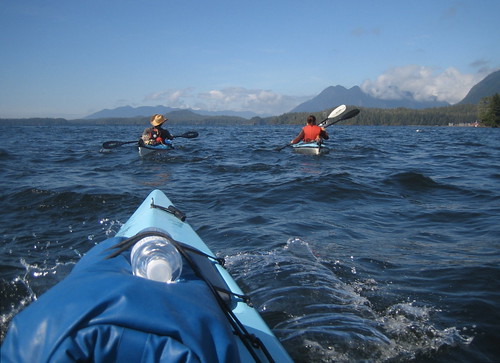
We passed by the oldest first nations reserve in North America, situated on Meares Island.. I think it was 4500 years old. Next, we stopped to eat some of the giant bull kelp floating around. Our guides pointed out the giant eagle nests on a small island and noted that in one nest, 47 cat collars had been found.
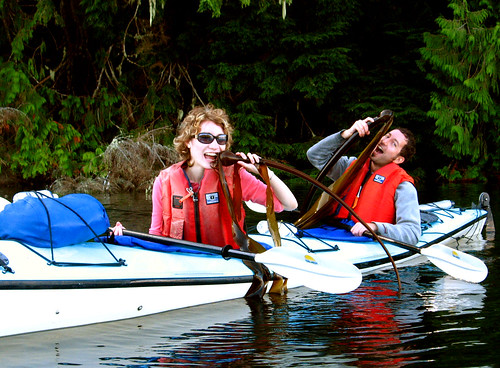
Paddling the kayak was smooth and more efficient than a canoe, also less tiring. Because of the full moon, tides were extremely high, and we basically had to latch our kayaks on to the rocks and trees of Meares Island. We were greeted by a rustic moss-tinged boardwalk that was hand-cut and laid by the local native kids who gathered to stop logging 20 years ago. Our guides pointed out various lichen, ferns and edible berries, as well as hemlock, red and yellow cedar. Each tree we passed was larger and older than the next – the largest being 1400 years old. The inside was hollow, and we crawled in.
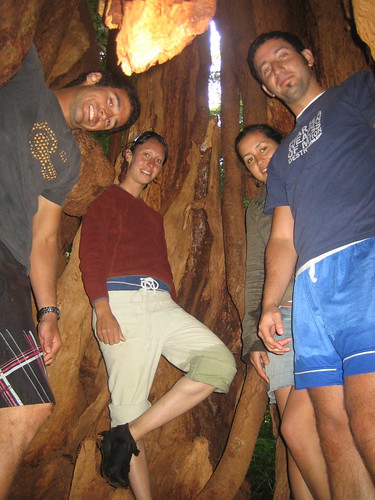
The forest had the most amazing, clean smell. Like fresh laundry that’s dried on a clothesline ( Martin says I should say 'like wet laundry that has been washed with unscented detergent,' but since so many soaps and air freshners are made to smell like 'forest breeze' or 'morning dew,' the scented detergent analogy works just fine. Plus the dry laundry will have a natural outdoorsy scent from being hung outside all day). Daniel pointed out the Old Man’s Beard lichen, which is the first plant to disappear at the sign of pollution, and thus what biologists look for to gauge the health of the forest.
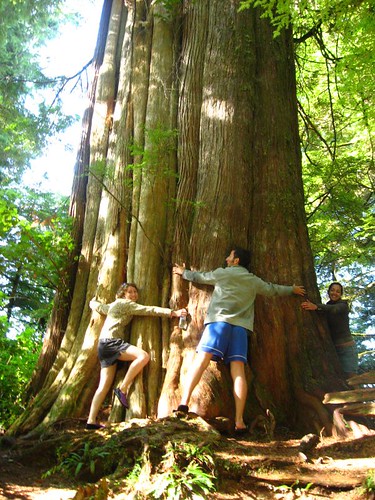
On the way back, we were paddling against the current. Our guide showed us how to aim 90 degrees from our intended destination, in order to allow ourselves to be carried sideways by the current. At one point however, Gord and I got carried away by the current. It was quite alarming, and reminded me of the strong rapids on the Gangwon rafting trip earlier this summer. No matter how hard we paddled, we were pulled downstream, and around a bend. Kat and Viva were out of sight, but Daniel, a strong kayaker, was literally dancing circles around us in his one-man kayak. Instinct dictates paddling fast, but he coached us to take long, slow strokes, and eventually, after three separate attempts, we made it out of our rapids and around the corner. What a relief - it definitely freaked me out a little.
The rest of the trip back was smooth sailing and good weather. The next day, we went to the Wikanninish Educational Centre, which was definitely worthwhile, save for the cheesy Parks Canada movie. We then took off on a hiking trail that lead us to South Beach, a gorgeous smooth-pebbled beach with tall, precarious-looking rocks and crashing waves that reminded me of photos of the east coast.
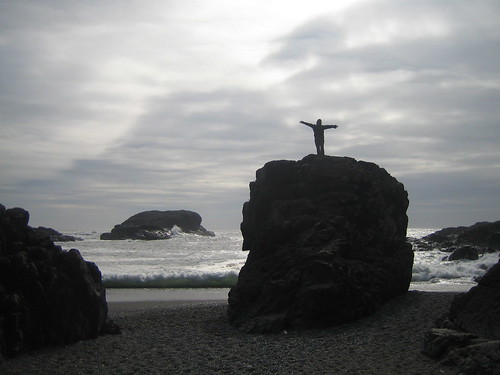
We lay around on the rocks, collected shells, and I made some shell art forms. We hiked on through a bog, and saw Labrador tea, lots of salal berries, and peat moss. It was late when we hit the second beach, and thankfully an older couple from Edinborough gave us a ride back to Wikanninish.

We had a small campfire on the beach, for about half an hour (enough time to make hot chocolate and toast a marshmallow) before a giant, unloved man in black shone a flashlight in our faces and asked us to put it out. Campfire ban still in effect, after 2 days of solid rain.

Other highlights of the trip included the best chocolate I ever laid fangs on, courtesy of Tofino Chocolates. Their chocolate is made with local ingredients, such as bog cranberries, and is completely organic. I also went down to our personal backyard beach a few more times, to inspect the sealife, and watch as the little tongues shot out of the barnacles to rake in micro-organisms from the water.
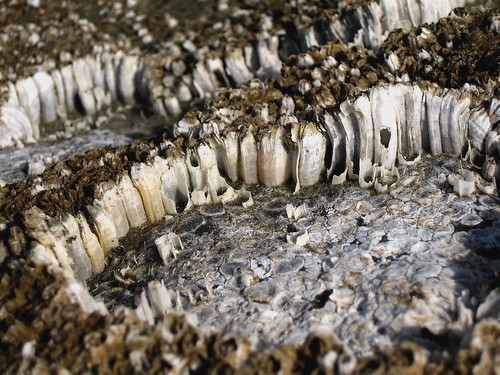
Before we left, we all filled waterbattles with beach powder (hesitant to call it sand), and filled our pockets with driftwood gathered from Big Beach and Little Beach in Uclulet. What sort of creations will be made from these is yet to be determined.
I was very sad to leave Tofino once again, but it has inspired preliminary talks regarding a) hiking the Westcoast Trail , b) winter camping and c) visiting the Queen Charlotte Islands, in the future. It has also renewed my interest in First Nations history, wilderness survival, and identifying plants and marine life.
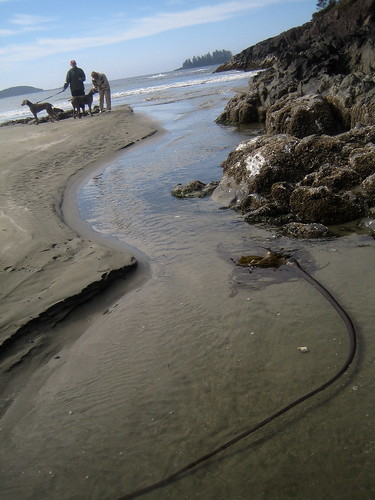

The next day was spent gathering info and deciding what to do. We ate fish and chips again at the Sea Shanty – permanently etched in my mind last year not only for the food, but also for its beautiful view of Tofino Air floatplanes taking off in the harbor. We then signed up for a four-hour kayaking tour, and then headed over to Schooner trail, a short boardwalk that leads down to the northern edge of Long Beach.

The rain was refreshing and we spotted a bear near our hiking trail. The weather ensured no other hikers on our trail. Bursting out of the forest in our tacky yellow ponchos, we came upon the most spectacular rainy beach – first nations reservation in the forest to our left, and rocky islands and a low tide in front of us.

Hours drifted and blended as we poked and prodded at sea anemones, starfish, clams, and barnacles. Kat was particularly intrigued with these clams buried under the sand that shot water in our faces. After observing them for a while, she determined that they have an in-valve and an out-valve. I thought that they were perhaps geoducks, a kind of clam that burrows under the sand (to avoid the hungry Chinese). We tried to grab the clams but they burrowed too fast and we couldn’t even find them when we dug at the spot.

Other tidal pools had little fast brown spotted fish, and larger flat fish that completely blended in with the sand. We caught some flat fish and hermit crabs and put them back. The island had extremely black rocks and a small forest of brilliant fall colours.. but it was dusk and we hiked back on the pitch-black trail, scaring each other re: the bear.
After various amazing meals cooked by Gord on the Coleman stove (despite the rain, there was a fire ban in all campsites except the national park), Saturday rolled around, and we hopped into our kayaks. It was the three of us, and two guides, Daniel and Viva. The main outline of the trip involved paddling across the protected waters between Tofino and Meares Island, walking in an old growth forest, and paddling back.

We passed by the oldest first nations reserve in North America, situated on Meares Island.. I think it was 4500 years old. Next, we stopped to eat some of the giant bull kelp floating around. Our guides pointed out the giant eagle nests on a small island and noted that in one nest, 47 cat collars had been found.

Paddling the kayak was smooth and more efficient than a canoe, also less tiring. Because of the full moon, tides were extremely high, and we basically had to latch our kayaks on to the rocks and trees of Meares Island. We were greeted by a rustic moss-tinged boardwalk that was hand-cut and laid by the local native kids who gathered to stop logging 20 years ago. Our guides pointed out various lichen, ferns and edible berries, as well as hemlock, red and yellow cedar. Each tree we passed was larger and older than the next – the largest being 1400 years old. The inside was hollow, and we crawled in.

The forest had the most amazing, clean smell. Like fresh laundry that’s dried on a clothesline ( Martin says I should say 'like wet laundry that has been washed with unscented detergent,' but since so many soaps and air freshners are made to smell like 'forest breeze' or 'morning dew,' the scented detergent analogy works just fine. Plus the dry laundry will have a natural outdoorsy scent from being hung outside all day). Daniel pointed out the Old Man’s Beard lichen, which is the first plant to disappear at the sign of pollution, and thus what biologists look for to gauge the health of the forest.

On the way back, we were paddling against the current. Our guide showed us how to aim 90 degrees from our intended destination, in order to allow ourselves to be carried sideways by the current. At one point however, Gord and I got carried away by the current. It was quite alarming, and reminded me of the strong rapids on the Gangwon rafting trip earlier this summer. No matter how hard we paddled, we were pulled downstream, and around a bend. Kat and Viva were out of sight, but Daniel, a strong kayaker, was literally dancing circles around us in his one-man kayak. Instinct dictates paddling fast, but he coached us to take long, slow strokes, and eventually, after three separate attempts, we made it out of our rapids and around the corner. What a relief - it definitely freaked me out a little.
The rest of the trip back was smooth sailing and good weather. The next day, we went to the Wikanninish Educational Centre, which was definitely worthwhile, save for the cheesy Parks Canada movie. We then took off on a hiking trail that lead us to South Beach, a gorgeous smooth-pebbled beach with tall, precarious-looking rocks and crashing waves that reminded me of photos of the east coast.

We lay around on the rocks, collected shells, and I made some shell art forms. We hiked on through a bog, and saw Labrador tea, lots of salal berries, and peat moss. It was late when we hit the second beach, and thankfully an older couple from Edinborough gave us a ride back to Wikanninish.

We had a small campfire on the beach, for about half an hour (enough time to make hot chocolate and toast a marshmallow) before a giant, unloved man in black shone a flashlight in our faces and asked us to put it out. Campfire ban still in effect, after 2 days of solid rain.

Other highlights of the trip included the best chocolate I ever laid fangs on, courtesy of Tofino Chocolates. Their chocolate is made with local ingredients, such as bog cranberries, and is completely organic. I also went down to our personal backyard beach a few more times, to inspect the sealife, and watch as the little tongues shot out of the barnacles to rake in micro-organisms from the water.

Before we left, we all filled waterbattles with beach powder (hesitant to call it sand), and filled our pockets with driftwood gathered from Big Beach and Little Beach in Uclulet. What sort of creations will be made from these is yet to be determined.
I was very sad to leave Tofino once again, but it has inspired preliminary talks regarding a) hiking the Westcoast Trail , b) winter camping and c) visiting the Queen Charlotte Islands, in the future. It has also renewed my interest in First Nations history, wilderness survival, and identifying plants and marine life.


3 Comments:
Gorgeous. Looks like a dream.
ahhhhhhhhhhhhhhh tooofino. so delightful, even without campfires. nice post and pics:D
That is so cool. I love the pictures!
Post a Comment
<< Home